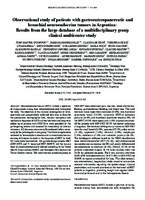Repositorio Digital
Observational study of patients with gastroenteropancreatic and bronchial neuroendocrine tumors in Argentina: Results from the large database of a multidisciplinary group clinical multicenter study
- DSpace Principal
- →
- Hospital El Cruce
- →
- Publicaciones
- →
- Artículos
- →
- Ver ítem
JavaScript is disabled for your browser. Some features of this site may not work without it.
Observational study of patients with gastroenteropancreatic and bronchial neuroendocrine tumors in Argentina: Results from the large database of a multidisciplinary group clinical multicenter study
O´Connor, Juan Manuel; Marmissolle, Fabiana; Bestani, Claudia; Pesce, Verónica; Belli, Susana; Dominichini, Enzo; Mendez, Guillermo; Price, Paola; Giacomi, Nora; Pairola, Alejandro; Sánchez Loria, Fernando; Huertas, Eduardo; Martin, Claudio; Patane, Karina; Poleri, Claudia; Rosenberg, Moises; Cabanne, Ana; Kujaruk, Mirta; Caino, Analia; Zamora, Victor; Mariani, Javier; Dioca, Mariano; Parma, Patricia; Podesta, Gustavo; Podesta, Oscar; Gondolesi, Gabriel; Roca, Enrique
Fecha:
2014
Resumen:
Neuroendocrine tumors (NET) include a spectrum of malignancies arising from neuroendocrine cells throughout the body. The objective of this clinical investigation of retrospectively and prospectively collected data was to describe the prevalence, demographic data, clinical symptoms and methods of diagnosis of NET and the treatment and long-term follow-up of patients with NET. Data were provided by the participating centers and assessed for consistency by internal reviewers. All the cases were centrally evaluated (when necessary) by the pathologists in our group. The tissue samples were reviewed by hematoxylin and eosin and immunohistochemical staining techniques to confirm the diagnosis of NET. In total, 532 cases were documented: 461 gastroenteropancreatic-NET (GEP-NET) and 71 bronchial NET (BNET). All the tumors were immunohistochemically defined according to the World Health Organization (WHO) and European Neuroendocrine Tumor Society criteria. The most common initial symptoms in GEP-NET were abdominal pain, diarrhea, bowel obstruction, flushing, gastrointestinal bleeding and weight loss. The most common tumor types were carcinoid (58.0%), non-functional pancreatic tumor (23.0%), metastatic NET of unknown primary (16.0%) and functional pancreatic tumor (3.0%). Of the BNET, 89.0% were typical and 11.0% atypical carcinoids. Of the patients with GEP-NET, 59.2% had distant metastasis at diagnosis. The locations of the primary tumors in GEP-NET were the small bowel (26.9%), pancreas (25.2%), colon-rectum (12.4%), appendix (7.6%), stomach (6.9%), esophagus (2.8%), duodenum (2.0%) and unknown primary (16.3%). The histological subtypes based on the WHO classification were well-differentiated NET (20.1%), well-differentiated neuroendocrine carcinomas (66.5%) and poorly differentiated neuroendocrine carcinomas (10.3%). Overall, 67.3% of the patients underwent surgery, 41.2% with curative intent and 26.1% for palliative purposes. The 5-year survival rates were 65.1% (95% confidence interval, 58.0-71.4%) in GEP-NET and 100.0% in typical carcinoid of the lung. This observational, non-interventional, longitudinal study aimed to accumulate relevant information regarding the epidemiology, clinical presentation and current practices in the treatment of NET patients in Argentina, providing insight into regional differences and patterns of care in this heterogeneous disease.
Descripción:
Fil: Caino, A. Hospital de Alta Complejidad en Red El Cruce Dr. Néstor C. Kirchner. Servicio de Medicina Nuclear. Florencio Varela, Argentina.
Ficheros en el ítem
Este ítem aparece en la(s) siguiente(s) colección(ones)
-
Artículos
Articles -
Mariani, Javier
Buscar
Listar
-
Todo DSpace
-
Esta colección

